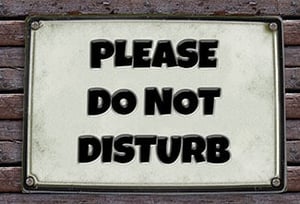In a recent article on eight simple productivity hacks, Forbes reported that those who multitask are not necessarily more productive. In fact, they are more distracted by "irrelevant environmental stimuli." Pick your distraction: Insta updates, iPhone notifications, texts, email, phone calls, the open-door-pop-in chat or can-you-stop-what-you're-doing-to-help-me chat. That doesn't even begin to address open-area work environments where distractions hit just about every one of the senses. What's more is that those same multitaskers also perform worse in tests that measure the ability to switch tasks. WHAT? Yes, multitaskers have a harder time switching from one task to another. At the end of the day, they have less boxes checked because they are more stressed out, less creative, and less patient.
Researchers at MIT found that the human brain can effectively track only two stimulants at once. When we multitask, our brains quickly dart back and forth from one thing to the next rather than actually doing both at once. Adding more things to focus on only puts our brains into overdrive -- or overload. 
Multitasking is almost never actually possible. Neuroscientists note that humans are wired to be “mono-taskers.” The only time we’re productively doing something that resembles multitasking is when one of the two tasks before you is automatic, like breathing or walking, or uses different systems such as folding laundry and watching TV.
Multitasking Risks
The act of multitasking dissipates your energy and causes a lack of focus as well as confusion, decreased production, fatigue and frustration. Hence the stress.
- Health Issues: Multitasking -- and the stress caused by it -- has been linked to a host of health issues such as weight gain, high blood pressure, and longer mental response time and short term memory loss. (Now, where did I put my ______?)
- IQ Drop: Since the mind has to slow down to take in the overload of stimuli, there is less of your mind available for recall and absorption. Consider how your computer, phone or streaming system reacts to too many requests at once. Does the phrase “not enough bandwidth” ring any bells? It’s the same with your brain and multitasking.
- Presence: When we’re busy trying to take in multiple things, we’re not actually fully present for any of them. For example, checking email while at the park with your children makes you miss out on fully engaging as a parent.
We THINK multitasking is making us more productive, but it actually hinders our progress. Not reaching our goals makes us irritable and THAT affects our relationships and our support system.
How DO We Get It All Done -- At Once?
Turns out, Philip Stanhope was right. Stanhope was the 4th Earl of Chesterfield, who gave sage advice to his son back in the 1700’s. He said, “There is time enough for everything, in the course of the day, if you do but one thing at once; but there is not time enough in the year, if you will do two things at a time.”
"Step away from your email and put your phone down."
So, if you want to get more done, plug the drains on your bandwidth. Streamline your life. Step away from your email and put your phone down. Block off time for your "big rocks" and focus on one task at a time. Do your tasks in batches – all your phone calls at once, all your emails at once, even cook all your meals at once. Sense a theme?
By handling tasks or items all at once, you give yourself the gift of focus. But, it’s not enough to just batch these efforts. You must actually DEAL with them at once too. For example, when you choose to open an email, commit to handling each email right then -- respond, forward or put the task on your "to do" list with a deadline, especially if it requires any kind of critical thinking. Critical thinking tasks require their own block of time. Create a plan for those tasks as well as for your day/week -- and work the plan.
Whether you work in an office setting or field setting, make sure you have all the tools, direction and materials you need before you start. Then, set your productivity goal, remove as many distractions as possible, and protect your time and productivity. Schedule your time deliberately so you can have the space and time you need to appropriately engage in the task at hand and be able to actually get it done.